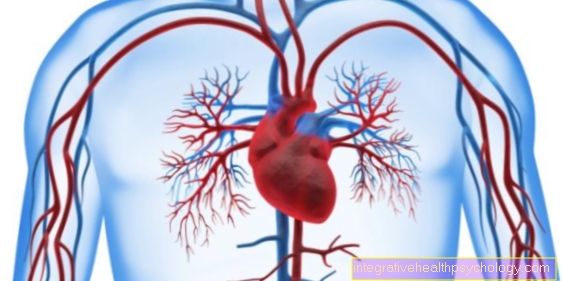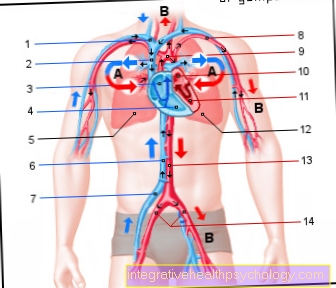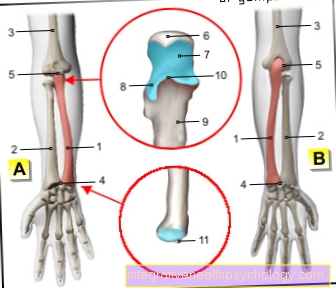Forms of obesity
Synonyms in a broader sense
Medical: Obesity
Obesity, obesity, obesity
definition
Obesity is a common problem in Western society. Due to an oversupply of food and the development of increasingly tasty food products, the problem of obesity will continue to gain in importance in the future.
The consequential costs of being overweight are already immense.
Body mass index
The measure that the WHO (world health organization) uses to determine obesity is the so-called body mass index. the body mass index takes into account the height and weight of the person in the calculation. You can find more about this calculation method under our topic Body Mass Index.
to form
Basically, one differentiates medically
- Abdominal obesity (fat on the stomach) and
- Peripheral obesity (fat on legs, arms, and especially buttocks)
WHR ("waist-to-hip ratio" = waist-to-hip ratio)
This is the division and risk classification of overweight with the help of circumference measurements.
The point is to estimate the regional fat distribution. This is done using the ratio of waist to hip certainly
Waist-hip ratio (WHR)
- Women:
- Abdominal Android Obesity:> 0.85
- Peripheral gynoid obesity: <0.85
- Men:
- Abdominal android obesity:> 1.0
- Peripheral gynoid obesity: <1.0
At the beginning of the 1980s, this method of assessing fat distribution on the basis of circumference measurements gained acceptance worldwide.
According to more recent ideas, measuring the waist circumference alone is sufficient for classification. The WHO also recommends this method.
Waist circumference (cm)
- Women:
- Moderately increased risk:> 80
- Risk greatly increased:> 88
- Men:
- Moderately increased risk:> 94
- Risk greatly increased:> 102
As early as 1947, medical professionals had discovered that an accumulation of fat in the abdomen was usually associated with other complications such as high blood pressure, increased Blood sugar and blood lipid levels. This is much less the case with fat accumulation on the hips.
Abdominal (android, visceral, central, "upper body obese") obesity

This is the "typical trunk obesity“With fat increase in the abdominal area (abdominal). The fat is not located in the subcutaneous fatty tissue, but in the abdomen itself (visceral). The term android (male) obesity comes from the fact that this form is found in around 80% of overweight men but only in 15% of women. The term apple shape ("apple type") is quite common.
This form of obesity often occurs in connection with other health disorders. These are those caused by the increased static load Joint problems how Hip osteoarthritis or Knee osteoarthritis and risk factors that can be found under the umbrella term "Metabolic syndrome“Sums up.
Metabolic Syndrome / Wealth Syndrome
metabolism means something like changed metabolism and is composed of the following health disorders:
- Abdominal obesity (Increased fat accumulation in the abdomen)
- Lipid metabolism disorder
- High blood sugar (type 2 diabetes)
- high blood pressure
Due to the increased risk arteriosclerosis (Calcification and narrowing of the arteries with secondary diseases such as stroke and Heart attack) to fall ill one speaks of a “deadly quartet” (fatal quartet).
Of the increased Blood sugar results from decreased insulin effectiveness. insulin is a hormone of the pancreas which regulates the blood sugar level. It ensures that sugar is transported from the blood to the cell, where it can be processed. Insulin lowers blood sugar.
You can find more information on this topic at insulin.
Within the metabolic syndrome the existing insulin is not able to lower the blood sugar level sufficiently because the described mechanism is disturbed. As a result, the blood sugar remains elevated, there is a reflex increased insulin level, but with insufficient effect of the hormone on the cells.
The causes of the metabolic syndrome are on the one hand genetic factors and on the other hand fhigh-fat diet, Sedentary lifestyle, alcohol, nicotine and stress. That is why the term "Wealth syndrome" embossed.
Please also read our article on this Consequences of being overweight
Peripheral (gynoid, gluteal-femoral, “lower-body-obese”) obesity
In this form of obesity, the increase in fat occurs primarily in the area of the hips and thighs (med. Gluteal-femoral).
"Gynoid" means that it occurs frequently in overweight women (approx. 85%). However, men (approx. 20%) are also affected.
It is also called pear type. In this form of obesity, metabolic concomitant diseases are not to be found more often than in people of normal weight. However, joint problems are just as common as those with abdominal obesity.





























